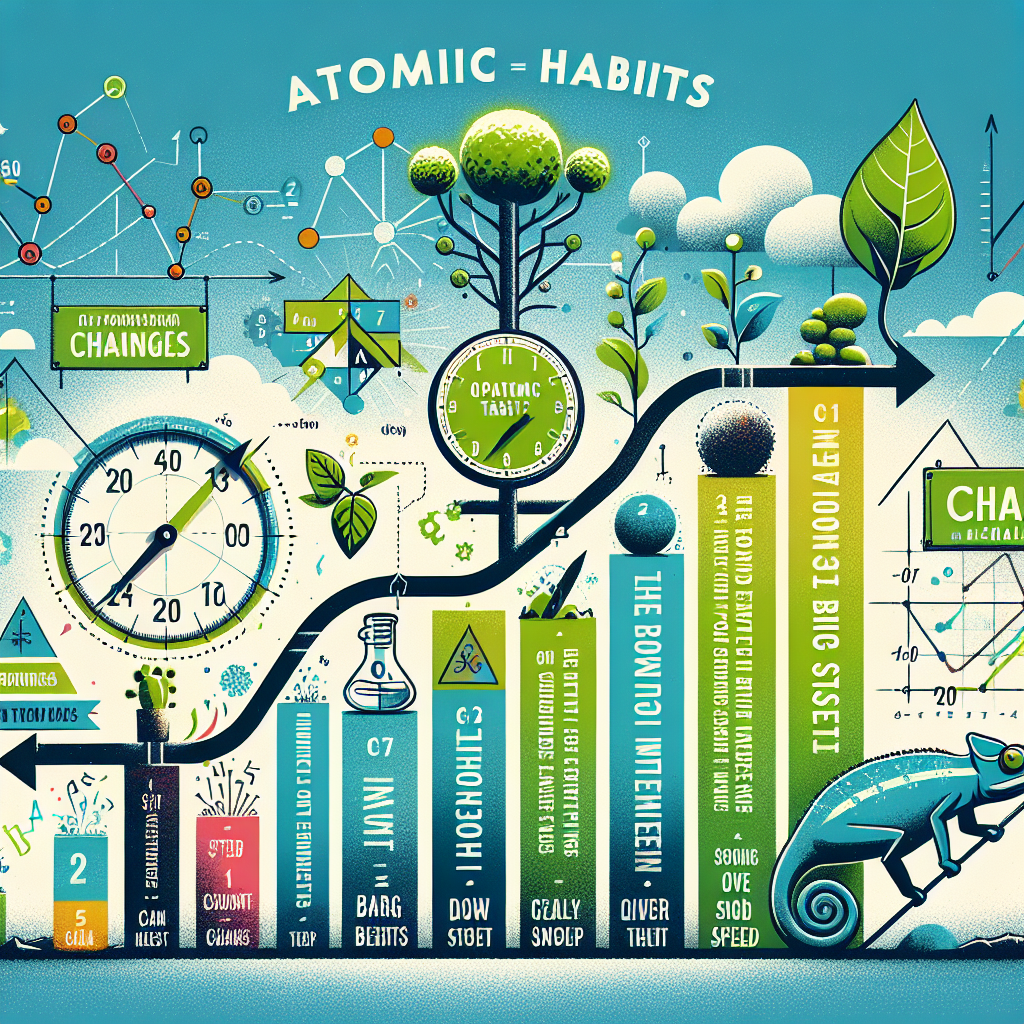
Building Effective Habits: Strategies from Atomic Habits
In ”Atomic Habits,” James Clear delves into the science of habit formation and offers practical strategies for building effective habits that can lead to personal success. One of the core principles Clear emphasizes is the power of small changes. Rather than attempting to overhaul your life overnight, he suggests focusing on tiny, incremental improvements. This approach, known as the aggregation of marginal gains, posits that small, consistent actions can compound over time to produce significant results. By making just a 1% improvement each day, you can achieve remarkable progress in the long run.
Transitioning from the concept of small changes, Clear introduces the idea of habit stacking. This technique involves linking a new habit to an existing one, thereby leveraging the established routine to create a new behavior. For instance, if you already have a habit of drinking coffee every morning, you could stack a new habit of reading a book for ten minutes right after your coffee. This method not only makes it easier to remember to perform the new habit but also integrates it seamlessly into your daily routine.
Another key strategy Clear discusses is the importance of environment in shaping our habits. He argues that our surroundings play a crucial role in determining our behavior. By designing an environment that supports your desired habits, you can make it easier to stick to them. For example, if you want to eat healthier, you could start by placing fruits and vegetables in visible and easily accessible locations in your kitchen. Conversely, you could make unhealthy snacks less accessible by storing them out of sight. This way, you are more likely to make healthier choices without having to rely solely on willpower.
Clear also highlights the significance of identity in habit formation. He suggests that the most effective way to change your habits is to focus on who you want to become rather than what you want to achieve. By adopting an identity-based approach, you align your habits with your self-image. For example, instead of setting a goal to run a marathon, you could focus on becoming a runner. This shift in perspective encourages you to adopt behaviors that are consistent with your new identity, making it easier to maintain your habits over time.
In addition to these strategies, Clear emphasizes the importance of tracking your progress. By keeping a record of your habits, you can gain valuable insights into your behavior patterns and identify areas for improvement. Habit tracking also provides a sense of accomplishment and motivation, as you can visually see your progress over time. Whether you use a simple checklist or a more sophisticated app, tracking your habits can help you stay accountable and committed to your goals.
Finally, Clear addresses the role of social influence in habit formation. He explains that the people we surround ourselves with can significantly impact our behavior. By associating with individuals who share your goals and values, you can create a supportive network that encourages positive habits. Conversely, distancing yourself from negative influences can help you avoid behaviors that are detrimental to your success.
In conclusion, ”Atomic Habits” by James Clear offers a wealth of practical strategies for building effective habits. By focusing on small changes, leveraging habit stacking, designing a supportive environment, adopting an identity-based approach, tracking progress, and harnessing social influence, you can create lasting habits that lead to personal success. These strategies, when applied consistently, can transform your life and help you achieve your goals.
The Power of Tiny Changes: How Small Habits Lead to Big Results
In ”Atomic Habits” by James Clear, the author delves into the profound impact that small, incremental changes can have on our lives. The central premise of the book is that tiny habits, when consistently practiced, can lead to significant and lasting improvements. This concept is both empowering and accessible, making it a valuable tool for anyone looking to achieve personal success.
One of the key takeaways from Clear’s work is the idea that habits are the compound interest of self-improvement. Just as money multiplies through compound interest, the effects of your habits multiply as you repeat them. They seem to make little difference on any given day, yet the impact they deliver over the months and years can be enormous. This perspective encourages us to focus on making small, manageable changes rather than attempting drastic overhauls that are often unsustainable.
Clear emphasizes the importance of identity in habit formation. He suggests that the most effective way to change your habits is to focus not on what you want to achieve, but on who you wish to become. For instance, instead of setting a goal to read more books, you might aim to become a reader. This subtle shift in mindset can make a significant difference because it aligns your habits with your identity, making them more likely to stick.
Another crucial aspect of ”Atomic Habits” is the four-step process of habit formation: cue, craving, response, and reward. Understanding this loop can help you design better habits and break bad ones. The cue triggers your brain to initiate a behavior, the craving provides the motivational force, the response is the actual habit you perform, and the reward is the end goal that satisfies your craving. By manipulating these elements, you can create a more conducive environment for positive habits to flourish.
Clear also introduces the concept of habit stacking, which involves linking a new habit to an existing one. This technique leverages the natural momentum of your current routines to make the adoption of new habits easier. For example, if you already have a habit of drinking coffee every morning, you could stack a new habit of reading a few pages of a book right after you finish your coffee. This method not only simplifies the process of habit formation but also makes it more likely that the new habit will become ingrained.
Moreover, the book highlights the significance of the environment in shaping our habits. Clear argues that we often overlook the power of our surroundings in influencing our behavior. By making small adjustments to our environment, such as placing healthier foods at eye level or keeping distractions out of sight, we can make it easier to adopt good habits and harder to fall into bad ones.
In addition to these strategies, Clear underscores the importance of tracking your habits. Keeping a habit tracker can provide a visual cue that reinforces your progress and keeps you motivated. It serves as a reminder of how far you’ve come and encourages you to maintain your streak.
Ultimately, ”Atomic Habits” offers a comprehensive guide to understanding and leveraging the power of small changes. By focusing on tiny, consistent improvements, aligning habits with your identity, understanding the habit loop, utilizing habit stacking, optimizing your environment, and tracking your progress, you can achieve remarkable results over time. The friendly and accessible tone of Clear’s writing makes these concepts easy to grasp and apply, empowering readers to take control of their habits and, consequently, their lives.
Breaking Bad Habits: Techniques to Overcome Negative Patterns
In ”Atomic Habits” by James Clear, the author delves into the intricacies of habit formation and offers practical strategies for breaking bad habits. One of the key takeaways is the importance of understanding the habit loop, which consists of a cue, a routine, and a reward. By identifying these components, individuals can gain insight into what triggers their negative behaviors and how to disrupt the cycle. For instance, if stress is the cue that leads to unhealthy snacking (the routine), and the reward is temporary relief, recognizing this pattern is the first step toward change.
Transitioning from awareness to action, Clear emphasizes the power of making bad habits less attractive. This can be achieved by reframing the mindset around the habit. For example, instead of viewing smoking as a stress reliever, one might focus on the long-term health consequences and the benefits of quitting. By altering the perception of the habit, its appeal diminishes, making it easier to resist.
Another effective technique discussed in the book is the concept of ”environment design.” Clear suggests that by modifying our surroundings, we can reduce the temptation to engage in negative behaviors. For instance, if one struggles with procrastination due to constant phone notifications, simply turning off notifications or placing the phone in another room can create a more conducive environment for productivity. This approach leverages the idea that our environment significantly influences our actions, often more than sheer willpower.
Moreover, Clear introduces the idea of ”implementation intentions,” which involves planning specific actions in response to certain cues. This strategy can be particularly useful for breaking bad habits. For example, if someone tends to overeat when they are bored, they might create an implementation intention such as, ”When I feel bored, I will go for a walk instead of reaching for a snack.” By having a predetermined plan, individuals can redirect their behavior more effectively when the cue arises.
In addition to these strategies, Clear highlights the importance of social support in overcoming negative patterns. Surrounding oneself with individuals who exhibit the desired behaviors can provide both motivation and accountability. For instance, joining a fitness group can encourage someone to stick to their exercise routine, as the collective effort and shared goals create a supportive environment. This social aspect can be a powerful catalyst for change, as humans are inherently influenced by the behaviors and attitudes of those around them.
Furthermore, Clear underscores the significance of self-compassion in the journey of breaking bad habits. He advises against harsh self-criticism when setbacks occur, as this can lead to a negative spiral and reinforce the unwanted behavior. Instead, adopting a mindset of self-forgiveness and viewing setbacks as learning opportunities can foster resilience and persistence. This compassionate approach helps maintain motivation and encourages continuous improvement.
Lastly, Clear’s concept of ”habit stacking” can be a valuable tool in replacing bad habits with positive ones. This involves linking a new, desired behavior to an existing habit. For example, if someone wants to reduce their screen time before bed, they might stack the new habit of reading a book onto their existing bedtime routine. By associating the new behavior with an established one, it becomes easier to integrate and sustain over time.
In conclusion, ”Atomic Habits” by James Clear offers a wealth of practical techniques for breaking bad habits and overcoming negative patterns. By understanding the habit loop, making bad habits less attractive, designing supportive environments, planning implementation intentions, seeking social support, practicing self-compassion, and utilizing habit stacking, individuals can effectively transform their behaviors and achieve personal success.
The Role of Environment in Shaping Your Habits
In ”Atomic Habits” by James Clear, one of the most compelling insights revolves around the role of environment in shaping your habits. Clear argues that while motivation and willpower are often emphasized in the pursuit of personal success, the environment in which you operate plays an equally, if not more, significant role. By understanding and optimizing your surroundings, you can create a conducive atmosphere for positive habits to flourish and negative ones to diminish.
To begin with, Clear emphasizes that our environment is the invisible hand that shapes human behavior. This means that the spaces we inhabit and the objects we interact with can either support or hinder our efforts to build good habits. For instance, if you aim to read more books, placing a book on your nightstand makes it more likely that you will pick it up before bed. Conversely, if you want to reduce your screen time, keeping your phone in another room can help you resist the urge to mindlessly scroll through social media.
Moreover, Clear introduces the concept of ”environment design,” which involves intentionally structuring your physical space to make good habits easier and bad habits harder. This can be as simple as rearranging your kitchen to place healthy foods at eye level or as complex as redesigning your workspace to minimize distractions. By making small adjustments to your environment, you can create a setting that naturally encourages the behaviors you want to adopt.
Transitioning to another key point, Clear also discusses the importance of cues in habit formation. Cues are the triggers that initiate a habit, and they are often embedded in our environment. For example, the sight of a coffee machine might cue you to make a cup of coffee, or the sound of an alarm might cue you to start your morning routine. By strategically placing cues in your environment, you can create a series of prompts that guide you toward your desired habits. For instance, laying out your workout clothes the night before can serve as a cue to exercise in the morning.
In addition to physical cues, social environments also play a crucial role in shaping our habits. Clear points out that we are heavily influenced by the people around us. If you surround yourself with individuals who embody the habits you aspire to develop, you are more likely to adopt those habits yourself. This is why joining a community or group that shares your goals can be incredibly beneficial. Whether it’s a fitness class, a book club, or a professional network, being part of a supportive environment can provide the encouragement and accountability needed to sustain your habits.
Furthermore, Clear highlights the concept of ”choice architecture,” which involves designing your environment in a way that makes the best choice the easiest one. For example, if you want to drink more water, placing a water bottle on your desk makes it more accessible than sugary drinks. By simplifying the decision-making process, you reduce the friction associated with adopting new habits.
In conclusion, James Clear’s ”Atomic Habits” underscores the profound impact that environment has on habit formation and personal success. By thoughtfully designing your physical and social surroundings, you can create an environment that naturally supports your goals. Whether it’s through environment design, strategic cues, or choice architecture, the power to shape your habits lies within the spaces you inhabit. By leveraging these insights, you can set yourself up for lasting success and continuous improvement.
The Four Laws of Behavior Change: A Deep Dive into Atomic Habits
In ”Atomic Habits,” James Clear presents a compelling framework for understanding and implementing behavior change, which he encapsulates in the Four Laws of Behavior Change. These laws serve as a guide to help individuals build good habits and break bad ones, ultimately leading to personal success. The first law, ”Make it Obvious,” emphasizes the importance of clarity and visibility in habit formation. Clear suggests that by making cues for desired behaviors more apparent, we can more easily integrate these actions into our daily routines. For instance, placing a book on your pillow can serve as a visual reminder to read before bed, thereby making the habit of reading more obvious and easier to adopt.
Transitioning to the second law, ”Make it Attractive,” Clear delves into the role of motivation and desire in habit formation. He argues that by associating positive emotions with a new habit, we can increase our likelihood of sticking with it. This can be achieved through a technique called ”temptation bundling,” where you pair an action you want to do with an action you need to do. For example, if you enjoy listening to podcasts but need to exercise more, you could make a rule that you can only listen to your favorite podcast while working out. This way, the attractiveness of the podcast motivates you to engage in the exercise habit.
Moving forward, the third law, ”Make it Easy,” focuses on reducing the friction associated with performing a new habit. Clear explains that by lowering the barriers to entry, we can make it simpler to adopt new behaviors. One effective strategy is the ”two-minute rule,” which suggests that any new habit should take no more than two minutes to complete initially. This approach helps to overcome procrastination and makes it easier to get started. For example, if you want to develop a habit of writing, start by committing to write for just two minutes each day. Over time, this small action can build momentum and lead to more substantial writing sessions.
Finally, the fourth law, ”Make it Satisfying,” highlights the importance of immediate rewards in reinforcing new habits. Clear points out that our brains are wired to seek instant gratification, so providing a tangible reward immediately after completing a new habit can help solidify it. This could be as simple as checking off a task on a to-do list or treating yourself to a small indulgence after completing a workout. The key is to ensure that the reward is directly tied to the habit, making it more satisfying and likely to be repeated.
In conclusion, James Clear’s Four Laws of Behavior Change offer a practical and effective roadmap for anyone looking to improve their habits and achieve personal success. By making habits obvious, attractive, easy, and satisfying, we can create an environment that supports positive behavior change and helps us reach our goals. Whether you’re aiming to read more, exercise regularly, or develop any other beneficial habit, these principles provide a solid foundation for lasting change.
We have lots of exciting coming events in Entrepreneurship, Investing and Personal Development. You can find them all here:
www.swedishwealthinstitute.se/events




